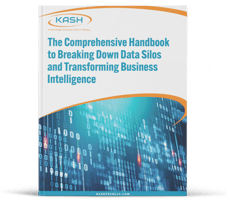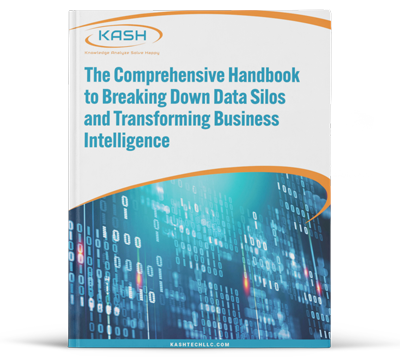Contents
Introduction
The global market for business intelligence is forecast to reach nearly $30 billion by 2027. Advancements in artificial intelligence, machine learning, and predictive analytics are providing significant insights to many of the world’s most profitable enterprises. Intelligent automation and business process automation are accelerating the speed and accuracy of business systems and allowing companies to leverage their data in new and innovative ways.
However, there are challenges involved in data transformation. Becoming a data-driven organization requires breaking down data silos and embracing a holistic approach to data. This eBook will take a deep dive into the challenges, potential solutions, and recommendations for overcoming problems associated with creating a comprehensive and successful business intelligence transformation.
The sheer volume of data being collected today is enormous. Yet nearly 93% of the data gathered goes unused. Why? It’s often locked away in business systems and data silos and thus inaccessible broadly across the organization.
Much of the data is unstructured, which may not fit neatly into legacy business intelligence systems. Data sources and data warehouses may not be configured properly for easy access by business users.
These are just a few reasons companies face challenges when implementing BI transformation.
Download Your Personal
Copy of the eBook
 Topics covered:
Topics covered:
- The impact of data silos on the organization
- Common challenges businesses face when trying to remove data silos
- How to find the best provider to help your organization implement a solution
Fill out the form to receive your copy of the eBook.
Download the eBook
The Importance of Eliminating Data Silos & Transforming Business Intelligence
Failing to solve these challenges can impair even the most data-driven companies. For example, different people can come up with significantly different results without a single source of truth. Managers might come to meetings with completely different insights gleaned from multiple data sources or variants of the same data. In some cases, insights and strategies may conflict.
Even if the data is accurate, it may not be complete. This can lead to making poor business decisions. In the end, users may lose trust in the data, rendering a company’s BI transformation efforts unsuccessful.
Failing to overcome these challenges can contribute to the following:
- Additional costs
- Lost revenue
- Customer dissatisfaction
- Wasted employee time
- Lack of accountability
- Increased complexity
- Animosity and finger-pointing
When systems break down like this, decision-makers lose sight of the underlying business insights and run the business on gut instinct instead of actionable information.

Common Challenges with Breaking Down Silos and Transforming Business Intelligence
Here are some of the most common questions organizations ask when trying to overcome the
challenges associated with breaking down silos and transforming business intelligence:
- How can digital transformation help my business?
- How do I bring various sources of data together to support our analytics?
- How do you transform the business into a data-driven organization?
- What does data transformation mean?
- How do I diagnose and correct data inconsistencies and errors?
- What are the best methods to eliminate data silos in our business?
- What is data virtualization versus a data warehouse to make data more accessible?
- How can the cloud help me with my information management challenges?
These are the right questions to ask. The answers can help you build the right solution for your business. However, traditional approaches to overcoming these challenges are generally falling short.
Studies by McKinsey, Boston Consulting, KPMG, and Bain & Company all report that the risk of failure in digital transformation falls somewhere between 70% and 95%. Companies can spend a significant amount of time and money trying to overcome these challenges without achieving the desired results.
We’ll discuss alternatives and solutions that can help, but first, let’s examine why traditional approaches aren’t solving the problem.

Why Traditional Approaches Aren’t Working
With the best intentions, companies have built solutions that, over time, haven’t kept up with the changing needs of the new business environment and, as a result, have lost the impact and value that they originally possessed–these are referred to as “legacy” systems.
In most cases, attempts have been made to keep these systems relative by bolting on new hardware and software to meet evolving needs. Unfortunately, this approach has created significant technical debt that increases costs and makes it difficult to bring all of the data together in a comprehensive manner.
Outdated Processes
Enterprises invested significantly in older data transformation processes such as Extract, Transform, and Load (ETL). This approach is based on processing ‘batches’ of data (usually in the off hours) rather than real-time information processing. Batch processing will move the data to where it’s needed, but the number of data pipelines created with this method becomes cumbersome to manage and maintain and can delay access to the data that users need.
New Data Silos
In addition to existing data silos, businesses often need to create new data extracts in response to operational demands or as a quick way to address new analytics and reporting requirements. As a result, they may introduce new software and data pipelines that add to the problem.
No Single Source of Truth
Over time these legacy systems become pervasive across an organization, adding to the complexity of managing the technical infrastructure of the business and resulting in deploying even more reporting and analytics solutions to meet the needs of the business users. Many legacy BI platforms only have access to certain types of data sources, preventing analysts from having the complete picture of the information they need. To compensate for this lack of access, analysts will create new data silos, further exacerbating the root problem. Ultimately the situation becomes unmanageable, leading to inconsistencies in the data, which eventually undermines the trust in the results generated by the reporting and analytics applications.
Lack of Consistent Data Governance
Because of the pressure on IT to provide self-service access to information by the business, data is often created for specific or immediate needs without consideration for the appropriate data modeling practices required to create a holistic and accurate data analytics platform. Disparate data integration and business rules proliferate, leading to serious data governance issues.
Relying on Spreadsheets
Even with reliable data sources and strong governance, many companies still need to rely on spreadsheets rather than properly using their data assets directly and correctly. This only adds to the number of data sources quickly becoming outdated or out of sync.
The bottom line is these traditional approaches create more data silos, increase complexity and ultimately result in creating less trust in the data itself.

Potential Solutions & Alternatives
There are multiple approaches to solving these challenges, and it is important to consider them all to identify the best-of-fit solution for your organization.
Remember, a best-of-fit solution is the one that meets your people, process, and
technology where you are and melds neatly into your business.
Solve the Challenges In-House
Leveraging your in-house subject matter experts is often the first consideration for most businesses. And any solution should leverage this tribal knowledge to provide the best solution. However, your in-house expertise will not necessarily extend to the latest and most effective technologies available, and you will still need external experts in these areas. Additionally, tying up employees to create a holistic, enterprise-level solution will also introduce risk and create additional problems. Employees don’t have the time to find a solution and implement it themselves without impacting their daily operational responsibilities. Even experienced IT
teams may not have the breadth of experience — or availability — needed to implement such an enterprise solution.
Rely on Software Vendors or Cloud Service Providers
While it would be great to pull a product off the shelf and deploy it, it doesn’t work that way. Every company has different data sources, systems, and processes that require custom solutions. Software vendors will approach businesses to buy more software to fix the issues, but they are locked into their product offerings and rarely take a holistic best-of-fit approach. Cloud service providers (CSPs) will likely be part of any digital transformation, but each CSP has its pros and cons. Different providers work better and more efficiently at different aspects of data storage, data virtualization, data processing, and data democratization. The best solution typically does not lie with any one CSP.
Use Consulting Companies
Consulting companies may help create a strategy but may not implement it. Others will implement technology but do not drive a strategy to custom-fit a solution to your business needs. They may rely on best-of-breed technology instead of a best-of-fit approach.
With best-of-fit, the consulting company takes responsibility for the strategy and builds it
to fit the needs of your business’s people, processes, and technology.
What Do Industry Experts Say?
Industry experts will tell you that any of the solutions will have advantages and disadvantages but are all viable depending on your pain threshold and budgetary constraints.
There’s an old saying that applies here; there are three critical aspects to any project: speed, quality, and low cost. You can have any two, but you can’t have all three. Delivering high-quality solutions requires time and investment.
Each party that provides a solution will have its own biases. Buyers must understand any provider’s strengths, weaknesses, expertise, and bias.

Common BI Questions & Recommendations
Avoid any company that has a cookie-cutter solution that’s plug-and-play. Eliminating data silos and transforming business intelligence requires a considered analysis of your current infrastructure and processes to determine a custom, best-of-fit solution.
It takes careful analysis and expertise to craft the right solution for your business.
Earlier, we posed several questions that companies undergoing digital transformation are asking. In this section, we’ll provide answers along with our recommendations.
How Can Digital Transformation Help My Business?
For each type of business, digital transformation will look slightly different. The objective of digital transformation is to accelerate the creation and integration of data and the delivery of actionable BI to your team.
Solutions for overcoming challenges should focus on:
- Eliminating data silos and creating a single source of truth
- Empowering all users by democratizing data
- Improving stakeholder and customer engagement
- Optimizing processes and operations
- Decreasing costs
Companies that create truly data-driven organizations are accelerating processes to deliver more timely insights to increase efficiency and drive revenue opportunities.

How Do I Bring Various Sources of Data Together to Support Our Analytics?
time, this can create consensus among team members on the chosen solutions.
How Do You Transform the Business into a Data-Driven Organization?
“Data can only take an organization so far. The real drivers are people.” - Gartner
Organizations must also put into place the processes to organize their data into a single source of truth that is accessible to everyone within the organization. This includes investing in the right self-service tools that support new technologies such as:
- AI-driven insights
- Cloud-based data lakes
- Data virtualization
- Augmented analytics
Only then can you create a culture where data is easily accessible, insights are shared, and there is trust in the data across the organization.
What Does Data Transformation Mean?
How Do I Diagnose and Correct Data Inconsistencies and Errors?
1. Data Discovery includes data and API connectors to automatically discover data sources and schemas. It also includes mapping processes from the data at the source and employing pattern detection capabilities.
2. Trust in the data involves automated data quality features to automatically detect data errors, ML data quality check suggestions, the ability to monitor data, and data cleansing processes.
3. Data synchronization to standardize, match, and merge data from multiple sources into a single cleansed record and then send cleansed data back to the sources.
4. Data optimization that automates the data prep and cleansing processes for analytics and ensures that accurate data is accessible to all users within the organization.
What Are the Best Methods to Eliminate Data Silos in Our Business?
The second step would be to audit the different management systems to determine how data is collected and how data is used within the organization. The results will help define the use cases and resources needed to implement a single source of truth. The basic building blocks of a project to eliminate data silos within a business are:
- Integrating all existing data management systems.
- Cultivating a data culture that promotes transparency, sharing, and collaboration of data across the enterprise.
- Establishing a data governance and data security plan.
- Upgrading the company’s technology infrastructure to support the new data-driven requirements.
What Is Data Virtualization vs. Data Warehouses?
A data warehouse is a physical integration/movement of the data that requires building an ETL pipeline of the data from potentially multiple sources into a single repository before it can be made available to audiences for analytics purposes. Solutions include data lakes, and lake houses, as part of your data fabric.
How Can the Cloud Help Me with My Information Management Challenges?
Download Your Personal
Copy of the eBook
 Topics covered:
Topics covered:
- The impact of data silos on the organization
- Common challenges businesses face when trying to remove data silos
- How to find the best provider to help your organization implement a solution
Fill out the form to receive your copy of the eBook.
Download the eBook
How to Find the Best Provider to Help you Implement the Best-Fit Solution
Finding the right provider to help you implement the best-of-fit solution for your business will
require due diligence on your part.
Work with a business that only focuses on data and analytics rather than a business that
sells software, does only the strategy, or only implementation. There isn’t anything out of
the box or off the shelf to fix this problem.
Data and analytics are the DNA of KASH Tech, which means this is all we do. Our expertise is focused on solving these specific issues only. We provide end-to-end holistic services and own the entire process:
Understanding your people, process, and technology — is the path to finding the best-of-fit solution to help your organization streamline systems, trust the data, and build a data-driven business.
We are technology-agnostic. We have no agenda to sell specific software and no preconceived solution. Each client is given a unique solution to their challenges and needs.
We consider people and processes as well as technology in the solution. This also means we become part of your business team to uncover the challenges and needs. Your problems become our problems, and we define a solution around that.
We also build sustainable solutions. This means you won’t depend on other providers or us once the solution has been implemented. This is possible because KT does their consulting WITH the customer vs. OUTSIDE the customer’s team. The client has ownership in the success of the program.
Whether you work with KASH Tech or another consulting services company, here are some key things you should consider when evaluating any services provider. A quality provider should:
- Share the details of its methodology for solving the problem before you pay for the service(s).
- Have a defined process for uncovering the challenges that cause data silos and BI issues, and willingly share it before signing up.
- Include people, processes, and technology as part of their solution. It takes a concerted effort in all three areas for success.
- Have a robust and detailed assessment process that includes an in-depth analysis of your unique systems.
- Fit your organization’s personality. You want a collaborative partnership rather than someone with a canned solution that they force onto you.
- Take a technology-agnostic approach to create a custom solution that works best for you.
KASH Tech’s Four-Phase Process to Produce Strategic Solutions
At KASH Tech, we follow a four-phase process to address client’s needs and provide a custom solution to digital transformation challenges. Each client gets a Best-of-Fit solution for their unique configuration. This methodology includes a detailed analysis to provide a comprehensive strategy for implementation.
Discover how your organization can unlock advanced business intelligence, eliminate data silos, and create actionable business insights. Download the free eBook, KASH Tech’s Advanced Analytics Playbook: How to Unlock Breakthrough Business Insights.
If you’re ready to explore solutions, request a data and analytics discovery call from the KASH Tech team.

